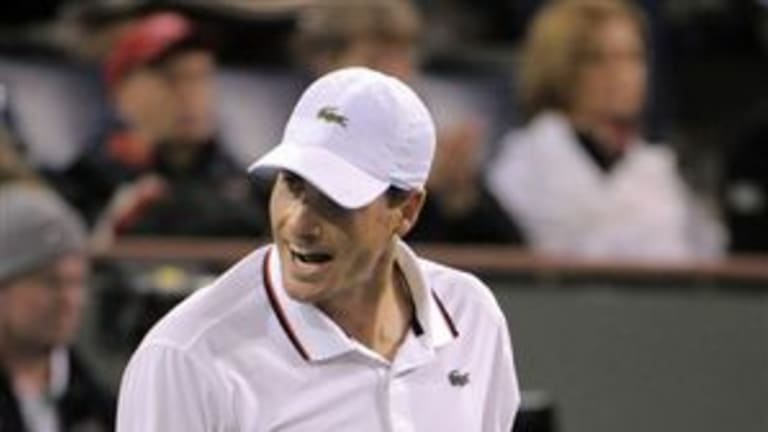INDIAN WELLS, CALIF.—It was hit and miss and hit and miss and hit and miss for John Isner in his quarterfinal tonight against Gilles Simon here. Over and over, forceful forehand was followed by netted forehand, as Isner tried to take control of points quickly against his consistent, underpowered opponent. The pattern held all the way to the final game.
With Simon serving at 5-6 in the third set, Isner began with another forehand into the tape, and followed it with two good ones to go up 15-30. Rather than throw in another miss at that point, as you might have expected, Isner came up with one more big ground stroke to reach 15-40 and match point. When Simon lofted a lazy backhand long on the next rally, Isner was into his first semifinal at Indian Wells, with a 6-3, 1-6, 7-5 win. The big guy, as he often does, came up with his best stuff when he needed it, at the very end.
He didn't begin with it. Isner came out flat, floating routine ground strokes long, and was broken in the first game. But Simon, who often struggles with a lead, couldn’t hold onto this one. In a long game at 3-2, Isner came through on his fourth break chance, winning the point with, naturally, a big forehand. A disappointed Simon temporarily disappeared, quicky losing the last three games of the set.
But the Frenchman returns too well and makes too many balls to let Isner off that easily. When Simon grabbed another 3-1 lead in the second set, he didn’t let it go. In the third there were no breaks; as the set progressed, each player began to hold more easily. It appeared that a tiebreaker was a foregone conclusion, until Isner’s ambush at 5-6.
It was, for the most part, a positive night for the American. After underachieving at Masters events for so long, he has reached the semifinals at two in a row, Paris last November and now Indian Wells. And this win takes him a step closer to the Top 10 for the first time. But while Isner was clutch at the end, it was a spotty performance overall, marked by more than 50 unforced errors.
On the one hand, this is how Isner has to play, particularly against someone as steady as Simon. Getting the first strike in is essential, and when you commit to that, errors are bound to come. On the other hand, Isner’s next opponent is Novak Djokovic. Against the game’s best returner, and one of its best defenders, he’s going to need many more hits than misses.
